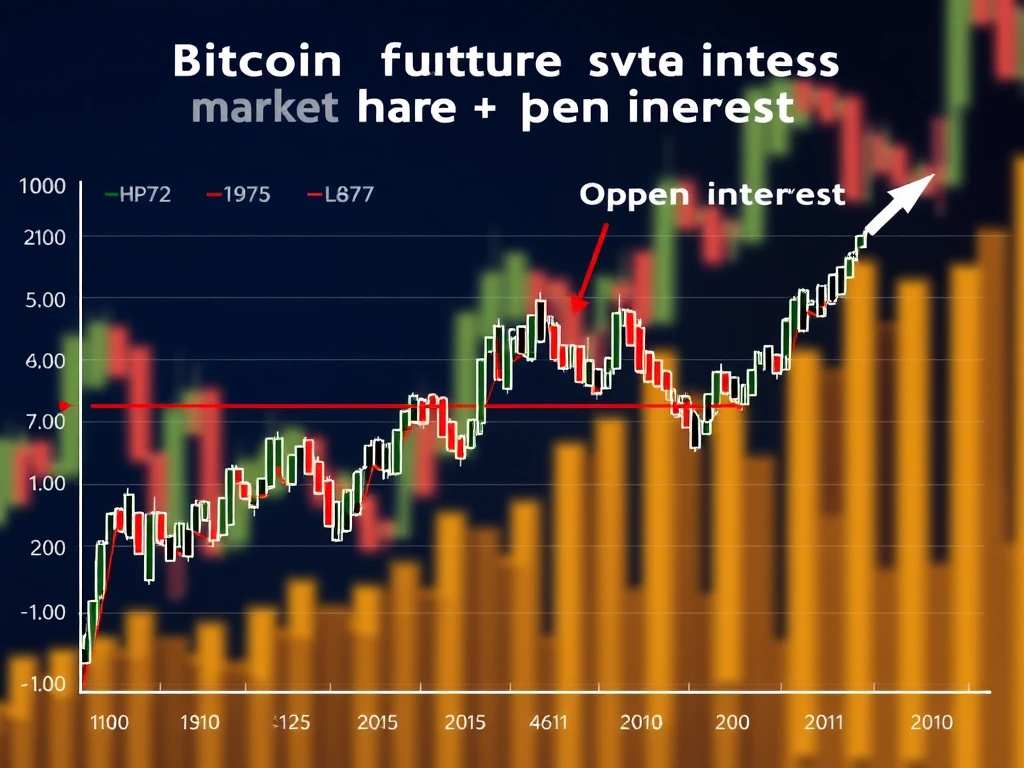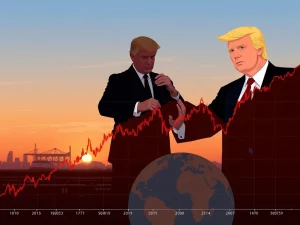Insightful Bitcoin Futures Divergences: Are Savvy BTC Bulls Accumulating?

Bitcoin recently dipped below the $80,000 mark, a level of support it hadn’t breached since November 2024. While this might trigger alarm bells for some, a deeper dive into the Bitcoin futures market reveals a fascinating story of divergence. Futures volumes have surged, indicating heightened activity, yet Bitcoin’s open interest has simultaneously plummeted. This contrasting picture begs the question: Are we witnessing a strategic accumulation by bullish investors, or is this a sign of traders reducing risk amidst market uncertainty?
Decoding Bitcoin Futures Divergences: A Market in Transition
Data from Glassnode highlights a striking 64% surge in Bitcoin futures volume over the past week. This is a significant shift from the previous month, which saw a progressive decrease in futures activity. Increased volume generally suggests more traders are active in the market, potentially indicating renewed interest or speculative fervor. However, looking at open interest provides a crucial contrasting perspective.
Open interest (OI), which represents the total value of outstanding futures contracts, has experienced a substantial 19% decline over the last two weeks. This decrease suggests that while trading volume is up, many traders are choosing to close their positions rather than keep them open. This could be for various reasons, such as:
- Profit Taking: Traders who bought Bitcoin futures at lower prices might be locking in profits as the price hovers near previous highs, albeit with recent dips.
- Risk Mitigation: Concerns about the current crypto market structure and broader macroeconomic factors might be prompting traders to reduce their exposure and limit potential losses.
- Market Correction Anticipation: Some traders might be anticipating a deeper market correction and closing positions preemptively to avoid being caught in a potential downturn.
The chart below from Glassnode illustrates this intriguing divergence:
[Bitcoin futures volume chart by Glassnode. Source: X.com] (Chart image would be inserted here in a real article)
What Does Increased BTC Futures Volume Mean for the Bull Market?
The rise in BTC futures volume can be interpreted in several ways, especially when considering the context of a potential market transition:
- Renewed Market Interest: Higher volume often signals increased participation and interest in Bitcoin. This could indicate that new capital is entering the market, or that existing participants are becoming more active.
- End of Correction?: A surge in volume during a price dip can sometimes signal the end of a correction phase. Traders might see the dip as a buying opportunity, increasing volume as they enter the market.
- Speculative Activity: Increased volume can also be driven by short-term speculative trading, especially if traders are trying to capitalize on price volatility.
However, to truly understand the market’s direction, we need to reconcile this increased volume with the simultaneous decrease in open interest.
The Puzzle of Declining Open Interest in Bitcoin Futures: A Cautious Approach?
The 19% drop in open interest paints a picture of caution among Bitcoin futures traders. This reduction suggests that despite the increased trading activity, many participants are not committed to holding long-term positions. Possible reasons for this decline include:
- Risk Aversion: Lingering macroeconomic uncertainties, such as inflation concerns and potential interest rate hikes, could be making traders more risk-averse.
- Liquidation Events: As highlighted by CoinGlass data, total crypto liquidations reached $2 billion between April 6th and 8th. These significant liquidations could be prompting traders to reduce leverage and overall exposure to the market.
- Bearish Market Structure Concerns: The fact that Bitcoin has closed below the $80,000 support level for several days might be interpreted as a bearish signal by some traders, leading them to reduce their long positions.
The total market liquidation chart from CoinGlass further supports the idea of a cautious market sentiment:
[Total market liquidation chart. Source: CoinGlass] (Chart image would be inserted here in a real article)
Bitcoin Market Analysis: Transition or Bear Trap?
The current divergence in Bitcoin market analysis points towards a market in transition. It’s a moment of uncertainty where the next direction is not yet clearly defined. Here’s how to interpret potential scenarios:
| Scenario | Market Action | Potential Interpretation |
|---|---|---|
| Bullish Accumulation | Bitcoin price recovers and rises, futures volume and open interest converge and increase. | Indicates the end of the correction and the start of a new accumulation phase, potentially leading to an uptrend. |
| Bearish Continuation | Bitcoin price fails to recover, futures volume and open interest remain divergent or open interest continues to decline. | Suggests the increased volume was driven by short-term speculation or profit-taking, and the underlying trend remains bearish, potentially signaling the beginning of a bear market. |
| Sideways Consolidation | Bitcoin price trades within a range, futures volume and open interest fluctuate without a clear trend. | Indicates market indecision and a period of consolidation before a clearer direction emerges. |
Institutional Investors and the Crypto Market: Spot Bitcoin ETF Insights
Interestingly, while traditional markets have faced significant downturns – with major US equities down over 20% from their highs – spot Bitcoin ETF outflows have remained relatively minimal. Despite the S&P 500 losing a year’s worth of growth in a short period, spot Bitcoin ETF data suggests a different story within the institutional crypto space.
Data from Sosovalue shows that total spot BTC ETF outflows over the past two weeks have been just under $300 million. This is a small figure compared to the potential panic selling one might expect given the turmoil in traditional markets.
[Total spot BTC ETF flows data. Source: Sosovalue] (Chart image would be inserted here in a real article)
This divergence suggests that institutional investors holding spot Bitcoin ETFs are not panicking in the same way as equity market participants. This could be due to several factors:
- Long-Term Investment Horizon: Institutions often have a longer investment timeframe and might view short-term market fluctuations as noise rather than reasons to sell.
- Bitcoin as a Hedge: Some institutions may be using Bitcoin as a hedge against traditional market volatility and inflation, making them less likely to sell during equity market downturns.
- Confidence in Long-Term Value: Despite short-term price corrections, institutional investors might maintain strong confidence in Bitcoin’s long-term value proposition.
Conclusion: Navigating the Bitcoin Market’s Crossroads
The current state of the Bitcoin market, characterized by diverging futures volume and open interest, presents a complex and potentially insightful picture. While the surge in volume could signal renewed interest and a possible end to the recent correction, the decline in open interest underscores a cautious, risk-averse approach among traders. The resilience of spot Bitcoin ETF flows amidst traditional market turmoil offers a glimmer of hope and suggests continued institutional conviction in Bitcoin.
Ultimately, whether this divergence resolves into a bullish accumulation phase or a deeper bearish trend remains to be seen. Monitoring the convergence or further divergence of futures volume and open interest, alongside Bitcoin’s price action, will be crucial in determining the market’s next significant move. For now, the Bitcoin market stands at a crossroads, demanding careful observation and strategic navigation.
Disclaimer: This article is for informational purposes only and does not constitute investment advice. Cryptocurrency trading involves substantial risk of loss. Always conduct your own thorough research and consider your risk tolerance before making any investment decisions.








